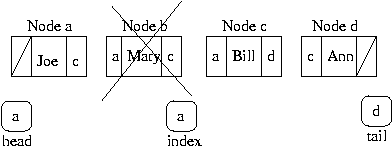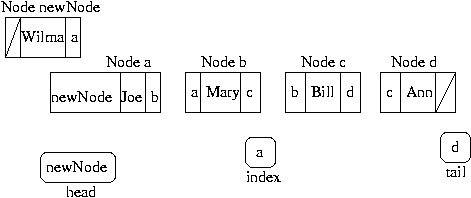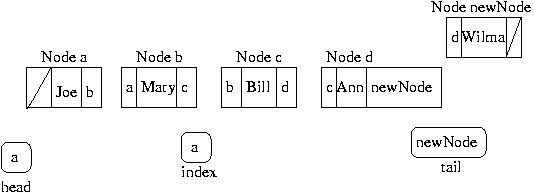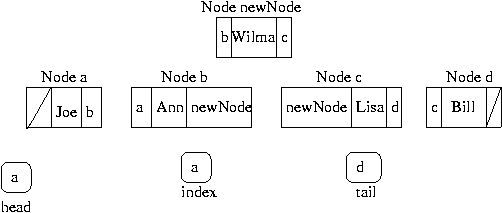The class decided to hold a review session Sunday evening at 8:00PM in the
cluster -- see ya there! Everyone was encouraged to review my old
exams on the Web, focusing ont he linked lsit and vector questions,
de-emphasizing Java syntax (remember, the mission of 15-200 has changed).
I volunteer you guys to beta-test a working-draft of the end of semester
exam. It won't be the same question -- and the format is a draft, not
the final product. But, it should still be good practice. We'll do that
during next week's recitation. It will involve writing methods internal
to a singly linked list, without the benefit of other linked list
methods.
One major advantage of linked lists over vectors is that we can remove an individual
node, and the garbage collector will eventually pick it up.
We can't reduce the size of a vector.
A downside of linked lists is that we don't have indexed access to the nodes.
If I want a node in the middle of the list, I have to start from the beginning of the list.
Linked lists have two other problems.
The first is that we can't go backwards. The reference in each node names only the next
item in the list.
The second problem is that if we need to remove, say, node b, our index must
reference node a, and then we must refer to index.getNext().getNext() in order to connect node a's
"next" reference to node c (dereferencing node b and effectively removing it
from the linked list).
Is there another way? There is, but it requires a list with one extra reference
in each node, a doubly-linked list.
3
Doubly-Linked lists are lists which contain slightly different nodes than the ones found in
singly-linked lists. Each node references its predecessor as well as its
successor. This allows us to
look and move both forward and backward in the list.Here's a doubly-linked list. Each node has an extra reference, which we
will call prev, to the node that comes before it in the linked list (its predecessor).
Take a look at Node b. It's prev reference refers to Node a, and its
next reference refers to Node c.
Look at Node a. The dashed line in Node a's prev signifies the fact
that, because Node a is the first node in the list, its prev is null.
Look at Node d. The dashed line in Node d's next signifies the fact that,
since Node d is at the end of the list, its next is null.

null is exactly what it sounds like - nothing. This means that
you cannot refer to null.getNext() or null.getPrev()!!!
The great thing about doubly-linked lists is that, if you'd like to, say,
remove the node in the above list containing "Mary", you can set index to refer
directly to node b and delete it. How do you do this?

The thing to notice here is that there is no longer a reference to Node b,
because Nodes a and c have been reset to reference each other. Index has been
reset to refer to the first node in the list.
Let's look at the doubly-linked list class. It's much like the singly-linked
list class. The nodes have an extra reference, a reference to their predecessors
in the list. And the methods are different because we now have one more
reference to worry about.
The Node Class
Instance Variables
private class Node
{
private Object data;
private Node next;
private Node prev;
//constructors and methods
}
prev is just like next, except that prev
refers to the node's predecessor.
Constructors
public Node()
{
data = null
next = null;
prev = null;
}
public Node (Object data)
{
this.data = data;
next = prev = null;
}
public Node (Object data, Node prev, Node next)
{
this.data = data;
this.next = next;
this.prev = prev;
}
Take a another look at the second two constructors.
What's the scope of data? What's the scope of this.data?
Remember that this refers to the object you've just
made with the new operator. We want to have meaningful variable names, so
these variables have the same name. Just keep the distinction between the
data being passed into the method and the instance variable of the object.
Accessors
public Object getData ()
{
return data;
}
public Node getPrev()
{
return prev;
}
public Node getNext()
{
return next;
}
Mutators
public void setData (Object data)
{
this.data = data;
}
We could leave setData() out of the class definition, because we can always
just create a new node
every time we want to change something. But that would be more work. When we make a new node,
we'll want to set its next and prev references.
public void setPrev (Node prev)
{
this.prev = prev;
}
public void setNext (Node next)
{
this.next = next;
}
As with singly-linked lists, the Node class is a private subclass of the doubly-linked
list class. Here's the rest of the doubly-linked list class.
The doubly-linked list class is like the singly-linked list class - except that there's one more
reference to worry about.
Instance Variables
private Node head;
private Node tail;
private Node index;
Constructor
public DoublyLinkedList()
{
head = tail = index = null;
}
Adding a Node to the Beginning of the List
public void addHead(Object data)
{
// Create new node
Node newNode = new Node (data, null, head);
// Special case: Empty List
if (null == head)
{
head = tail = index = newNode;
return;
}
// Common case
head.setPrev(newNode);
head = newNode;
}
Here, newNode has been added to the front of the list.

Adding a Node to the End of the List
public void addTail (Object data)
{
// Create new node
Node newNode = new Node (data, tail, null);
// Special case: Empty list
if (tail == null)
{
tail = head = index = newNode;
return;
}
// Common case
tail.setNext (newNode);
tail = newNode;
}
Here, newNode has been added to the end of the list.
Modifying the SinglyLinkedList Code from Class
As an exercise in thinking through LinkedLists, we modified
the code from last class to convert it from a singly linked list
to a doubly linked list.
We chose to modify the code for the two classes directly. But we could
also have, arhuably should have, extended the other class using inheritence.
This would allow us to directly reuse some of the common code and clearly
express the relationship, "A doubly linked list is a linked list".
But, as it turns out, we wouldn't actually get to reuse as much as we might
hope -- and this way matches the end-of-semester exam. It is also good
practice for next week's exam.
Modifying the SinglyLinkedList Code From Class: DLinkedListNode
public class DLinkedListNode
{
private Comparable data;
private DLinkedListNode next;
private DLinkedListNode prev;
public DLinkedListNode()
{
data = null;
next = null;
prev = null;
}
public DLinkedListNode (Comparable data, DLinkedListNode prev,
DLinkedListNode next)
{
this.data = data;
this.next = next;
this.prev = prev;
}
public DLinkedListNode (Comparable data)
{
this.data = data;
this.next = null;
this.prev = null;
}
public void setNext (DLinkedListNode next)
{
this.next = next;
}
public void setPrev (DLinkedListNode prev)
{
this.prev = prev;
}
public Comparable getData()
{
return data;
}
public DLinkedListNode getNext()
{
return next;
}
public DLinkedListNode getPrev()
{
return prev;
}
}
Modifying the SinglyLinkedListCode from Last Class: DLinkedList
public class DLinkedList
{
private DLinkedListNode head;
private DLinkedListNode tail;
private DLinkedListNode index;
public class DLinkedListException extends Exception
{
public DLinkedListException (String msg)
{
super(msg);
}
}
public DLinkedList()
{
head = tail = index = null;
}
public void prepend (Comparable data)
{
head = new DLinkedListNode (data, null, head);
if (head.getNext() != null)
head.getNext().setPrev(head);
if (null == tail)
tail = head;
if (null == index)
index = head;
}
public void append (Comparable data)
{
if (null == tail)
head = index = tail = new DLinkedListNode(data);
else
{
tail.setNext (new DLinkedListNode (data,tail,null));
tail = tail.getNext();
}
}
public void resetIndex()
{
index = head;
}
public Comparable getIndex() throws DLinkedListException
{
if (null == index)
throw new DLinkedListException ("Null index in getIndex()");
return index.getData();
}
public void advanceIndex() throws DLinkedListException
{
if ((index == null) || (null == index.getNext()))
throw new DLinkedListException ("Null index in advanceIndex()");
index = index.getNext();
}
public void reverseIndex() throws DLinkedListException
{
if ( (null == index) || (index == head) )
throw new DLinkedListException ("Index is null or has no predecessor");
index = index.getPrev();
}
public Comparable deleteAtIndex() throws DLinkedListException
{
Comparable data;
try
{
data = index.getData();
reverseIndex();
// data = index.getNext().getData(); // Ugly, but avoids NPE
index.setNext(index.getNext().getNext());
index.getNext().setPrev(index);
}
catch (NullPointerException npe)
{
throw new DLinkedListException ("index is null; can't delete");
}
catch (DLinkedListException lle)
{
// No predecessor; first node in list
head = index.getNext();
if (head != null)
head.setPrev(null);
}
// Index was the tail
if (index.getNext() == null)
{
tail = index;
}
// Move index to the one after the one we're deleting
index = index.getNext();
return data;
}
public Comparable removeNth (int n) // beginning with 0th
throws DLinkedListException
{
DLinkedListNode index; // Don't destroy user's index
int count;
if (null == head)
throw new DLinkedListException ("Can't delete from empty list");
if (n == 0)
{
if (tail == head)
tail = null;
if (index == head)
index = null;
head = head.getNext();
if (head != null)
head.setPrev (null);
}
else
{
try
{
for (index=head, count=0; count <= n; count++, index=index.getNext())
;
}
catch (NullPointerException npe)
{
throw new DLinkedListException ("Less than n nodes on removeNth");
}
if (index == tail)
throw new DLinkedListException ("Less than n nodes on removeNth");
if (this.index == index)
this.index = null;
if (tail == index)
tail = index.getPrev(); // same as tail=tail.getPrev()
index.getPrev().setNext(index.getNext());
if (tail != index)
index.getNext().setPrev(index.getPrev());
}
}
} /* DLinkedList */




